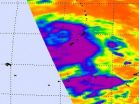(Press-News.org) CAMBRIDGE, Mass. -- A new study by civil engineers at MIT shows that using stiffer pavements on the nation's roads could reduce vehicle fuel consumption by as much as 3 percent — a savings that could add up to 273 million barrels of crude oil per year, or $15.6 billion at today's oil prices. This would result in an accompanying annual decrease in CO2 emissions of 46.5 million metric tons.
The study, released in a recent peer-reviewed report, is the first to use mathematical modeling rather than roadway experiments to look at the effect of pavement deflection on vehicle fuel consumption across the entire U.S. road network. A paper on this work has also been accepted for publication later this year in the Transportation Research Record.
By modeling the physical forces at work when a rubber tire rolls over pavement, the study's authors, Professor Franz-Josef Ulm and PhD student Mehdi Akbarian, conclude that because of the way energy is dissipated, the maximum deflection of the load is behind the path of travel. This has the effect of making the tires on the vehicle drive continuously up a slight slope, which increases fuel use.
The deflection under the tires is similar to that of beach sand underfoot: With each step, the foot tamps down the sand from heel to toe, requiring the pedestrian to expend more energy than when walking on a hard surface. On the roadways, even a 1 percent increase in aggregate fuel consumption leaves a substantial environmental footprint. Stiffer pavements — which can be achieved by improving the material properties or increasing the thickness of the asphalt layers, switching to a concrete layer or asphalt-concrete composite structures, or changing the thickness or composition of the sublayers of the road — would decrease deflection and reduce that footprint.
"This work is literally where the rubber meets the road," says Ulm, the George Macomber Professor in the Department of Civil and Environmental Engineering. "We've got to find ways to improve the environmental footprint of our roadway infrastructure, but previous empirical studies to determine fuel savings all looked at the impact of roughness and pavement type for a few non-conclusive scenarios, and the findings sometimes differed by an order of magnitude. Where do you find identical roadways on the same soils under the same conditions? You can't. You get side effects. The empirical approach doesn't work. So we used statistical analysis to avoid those side effects."
The new study defines the key parameters involved in analyzing the structural (thickness) and material (stiffness and type of subgrade) properties of pavements. The mathematical model is therefore based on the actual mechanical behavior of pavements under load. To obtain their results, Ulm and Akbarian fed their model data on 5,643 representative sections of the nation's roadways taken from Federal Highway Administration data sets. These data include information on the surface and subsurface materials of pavements and the soils beneath, as well as the number, type and weight of vehicles using the roads. The researchers also calculated and incorporated the contact area of vehicle tires with the pavement.
Ulm and Akbarian estimate that the combined effects of road roughness and deflection are responsible for an annual average extra fuel consumption of 7,000 to 9,000 gallons per lane-mile on high-volume roads (not including the most heavily traveled roads) in the 8.5 million lane-miles making up the U.S. roadway network. They say that up to 80 percent of that extra fuel consumption, in excess of the vehicles' normal fuel use, could be reduced through improvements in the basic properties of the asphalt, concrete and other materials used to build the roads.
"We're wasting fuel unnecessarily because pavement design has been based solely on minimizing initial costs more than performance — how well the pavement holds up — when it should also take into account the environmental footprint of pavements based on variations in external conditions," Akbarian says. "We can now include environmental impacts, pavement performance and — eventually — a cost model to optimize pavement design and obtain the lowest cost and lowest environmental impact with the best structural performance."
The researchers say the initial cost outlay for better pavements would quickly pay for itself not just in fuel efficiency and decreased CO2 emissions, but also in reduced maintenance costs.
"There's a misconception that if you want to go green you have to spend more money, but that's not necessarily true," Akbarian says. "Better pavement design over a lifetime would save much more money in fuel costs than the initial cost of improvements. And the state departments of transportation would save money while reducing their environmental footprint over time, because the roads won't deteriorate as quickly."
This research was conducted as part of the Concrete Sustainability Hub at MIT, which is sponsored by the Portland Cement Association and the Ready Mixed Concrete Research & Education Foundation with the goal of improving the environmental footprint of that industry.
"This work is not about asphalt versus concrete," Ulm says. "The ultimate goal is to make our nation's infrastructure more sustainable. Our model will help make this possible by giving pavement engineers a tool for including sustainability as a design parameter, just like safety, cost and ride quality."
### END
Civil engineers find savings where the rubber meets the road
Study shows that pavement deflection under vehicle tires makes for a continuous uphill drive that increases fuel consumption
2012-05-23
ELSE PRESS RELEASES FROM THIS DATE:
VCU Massey Cancer Center sees potential in novel leukemia treatment
2012-05-23
Richmond, Va. – (May 22, 2012) – Scientists at Virginia Commonwealth University Massey Cancer Center may be one step closer to developing a new therapy for acute myeloid leukemia (AML) after discovering that the targeted agents obatoclax and sorafenib kill leukemia cells much more effectively when combined than when the drugs are administered individually.
Recently published in the journal Blood, the results of a study led by Steven Grant, M.D., Shirley Carter Olsson and Sture Gordon Olsson Chair in Oncology Research, associate director for translational research and program ...
Scientists unravel role of fusion gene in prostate cancer
2012-05-23
NEW YORK (May 22, 2012) -- Up to half of all prostate cancer cells have a chromosomal rearrangement that results in a new "fusion" gene and formation of its unique protein -- but no one has known how that alteration promotes cancer growth. Now, Weill Cornell Medical College researchers have found that in these cancer cells, the 3-D architecture of DNA, wrapped up in a little ball known as a chromatin, is warped in such a way that a switch has been thrown on thousands of genes, turning them on or off to promote abnormal, unchecked growth. Researchers also found that new ...
Breast cancer clinical trial tests combo of heat shock protein inhibitor and hormonal therapy
2012-05-23
CAMBRIDGE, Mass. (May 22, 2012) – Pushed to the brink of survival, the hyper-driven cells of a cancerous tumor tap into an ancient system that has helped organisms cope with internal stresses and environmental challenges since life began. As an integral part of this system, heat shock protein 90 (HSP90) has been shown to help malignant cells accommodate the genetic changes and profound disturbances in normal biology that occur in cancers.
Researchers have theorized that inhibiting HSP90 just might render breast cancer cells less likely to escape the challenge posed ...
New study shows how nanotechnology can help detect disease earlier
2012-05-23
LEXINGTON, KY. (May 21, 2012) — A new study led by University of Kentucky researchers shows a new way to precisely detect a single chemical at extremely low concentrations and high contamination.
The study, published online for ACS Nano, was carried out in the laboratory of Peixuan Guo, the William S. Farish Endowed Chair in Nanobiotechnology at the University of Kentucky Markey Cancer Center. The study shows that the phi29 DNA packaging nanomotor connector can be used to sense chemicals with reactive thioesters or maleimide using single channel conduction assays based ...
The older we get, the less we know (cosmologically)
2012-05-23
The universe is a marvelously complex place, filled with galaxies and larger-scale structures that have evolved over its 13.7-billion-year history. Those began as small perturbations of matter that grew over time, like ripples in a pond, as the universe expanded. By observing the large-scale cosmic wrinkles now, we can learn about the initial conditions of the universe. But is now really the best time to look, or would we get better information billions of years into the future - or the past?
New calculations by Harvard theorist Avi Loeb show that the ideal time to study ...
Psychological Science explains uproar over prostate-cancer screenings
2012-05-23
WASHINGTON— The uproar that began last year when the U.S. Preventive Services Task Force stated that doctors should no longer offer regular prostate-cancer tests to healthy men continued this week when the task force released their final report. Overall, they stuck to their guns, stating that a blood test commonly used to screen for prostate cancer, the PSA test, causes more harm than good — it leads men to receive unnecessary, and sometimes even dangerous, treatments.
But many people simply don't believe that the test is ineffective. Even faced with overwhelming evidence, ...
Array of light for early disease detection?
2012-05-23
A special feature in this week's issue of the journal Science highlights protein array technology, touching on research conducted by Joshua LaBaer, director of the Biodesign Institute's Virginia G. Piper Center for Personalized Diagnostics.
With the successful completion of the Human Genome Project, research attention is increasingly focusing on proteins. Versatile products produced from genetic templates, proteins are principle actors in both the maintenance of health and the onset of illness. Protein microarrays are a means of bridging the gap between analysis of the ...
NASA Sees Eastern Pacific's Second Tropical Storm Form
2012-05-23
On May 21, NASA satellites were monitoring Tropical Depression 02E in the eastern Pacific Ocean, and 24 hours later it strengthened into the second tropical storm of the season. Tropical Storm Bud was captured by NOAA's GOES-13 satellite on May 22, and appears to be well-formed.
Tropical Storm Bud isn't going to stop there, however. According to the forecasters at the National Hurricane Center, Bud is expected to become a hurricane because of light to moderate wind shear and warm sea surface temperatures.
On May 22 at 0900 UTC (2 a.m. PDT/5 a.m. EDT), Tropical Storm ...
NASA satellite sees Tropical Storm Sanvu pass Guam, strengthen
2012-05-23
Tropical Depression 03W in the western North Pacific did exactly what forecasters expected over the last twenty-four hours: it became a tropical storm named Sanvu and passed west of Guam on a northwesterly track.
On May 22 at 0900 UTC (5 a.m. EDT), Tropical Storm Sanvu was more than 100 miles west-northwest of Andersen Air Force Base, Guam, and still over 600 nautical miles south of Iwo To, Japan and headed in that direction. Sanvu's center was located near 15.2 North and 141.9. East. It was still churning up rough surf around Guam. Sanvu has maximum sustained winds near ...
Barrow researchers use magic for discoveries
2012-05-23
(Phoenix, AZ May 22, 2012) -- Researchers at Barrow Neurological Institute at St. Joseph's Hospital and Medical Center have unveiled how and why the public perceives some magic tricks in recent studies that could have real-world implications in military tactics, marketing and sports.
Susana Martinez-Conde, PhD, of Barrow's Laboratory of Visual Neuroscience, and Stephen Macknik, PhD, of Barrow's Laboratory of Behavioral Neurophysiology are well known for their research into magic and illusions. Their most recent original research projects, published in Frontiers in Human ...
LAST 30 PRESS RELEASES:
The Ceramic Society of Japan’s Oxoate Ceramics Research Association launches new international book project
Heart-brain connection: international study reveals the role of the vagus nerve in keeping the heart young
Researchers identify Rb1 as a predictive biomarker for a new therapeutic strategy in some breast cancers
Survey reveals ethical gaps slowing AI adoption in pediatric surgery
Stimulant ADHD medications work differently than thought
AI overestimates how smart people are, according to HSE economists
HSE researchers create genome-wide map of quadruplexes
Scientists boost cell "powerhouses" to burn more calories
Automatic label checking: The missing step in making reliable medical AI
Low daily alcohol intake linked to 50% heightened mouth cancer risk in India
American Meteorological Society announces Rick Spinrad as 2026 President-Elect
Biomass-based carbon capture spotlighted in newly released global climate webinar recording
Illuminating invisible nano pollutants: advanced bioimaging tracks the full journey of emerging nanoscale contaminants in living systems
How does age affect recovery from spinal cord injury?
Novel AI tool offers prognosis for patients with head and neck cancer
Fathers’ microplastic exposure tied to their children’s metabolic problems
Research validates laboratory model for studying high-grade serous ovarian cancer
SIR 2026 delivers transformative breakthroughs in minimally invasive medicine to improve patient care
Stem Cell Reports most downloaded papers of 2025 highlight the breadth and impact of stem cell research
Oxford-led study estimates NHS spends around 3% of its primary and secondary care budget on the health impacts of heat and cold in England
A researcher’s long quest leads to a smart composite breakthrough
Urban wild bees act as “microbial sensors” of city health.
New study finds where you live affects recovery after a hip fracture
Forecasting the impact of fully automated vehicle adoption on US road traffic injuries
Alcohol-related hospitalizations from 2016 to 2022
Semaglutide and hospitalizations in patients with obesity and established cardiovascular disease
Researchers ‘listen in’ to embryo-mother interactions during implantation using a culture system replicating the womb lining
How changing your diet could help save the world
How to make AI truly scalable and reliable for real-time traffic assignment?
Beyond fragmented markets: A new framework for efficient and stable ride-pooling
[Press-News.org] Civil engineers find savings where the rubber meets the roadStudy shows that pavement deflection under vehicle tires makes for a continuous uphill drive that increases fuel consumption


